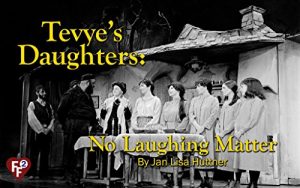The Crawley sisters of Downton Abbey? The Bennet sisters of Pride & Prejudice? The daughters born to Zelophehad of the Tribe of Manasseh? Why mention any of these women in the same breath as the beloved characters in the Broadway musical Fiddler on the Roof?
Conventional wisdom has it that Fiddler on the Roof is about Tevye, a beleaguered patriarch persecuted by his neighbors and “desperately clinging to Tradition.” But in this surprising eBook, Jan Lisa Huttner turns the reader’s focus away from Tevye and onto his daughters.
What is tradition? Who makes the matches? Should people who want to marry each other be allowed to make that choice? These questions are just as important now as they were fifty years ago—in 1964—when Fiddler on the Roof made its original debut on the Broadway stage.
Other recent books have discussed the stories of Sholem Aleichem and the canvases of Marc Chagall, the two undisputed sources of Fiddler on the Roof. But for Huttner, the creators of Fiddler on the Roof were also participants in a Great Conversation about women’s rights conducted over a span of two thousand years from the original compilation of the Hebrew Bible right up to the present day.
Huttner examines the “synergies” that made Fiddler on the Roof such a phenomenal—and unexpected—success back in 1964. These synergies not only help account for Fiddler on the Roof’s extraordinary longevity, but also explain why stage performances of Fiddler on the Roof continue to be so resonant today.
Huttner writes in a lively style but her intent is deeply serious. When we skip over, trivialize, or otherwise ignore the female characters in Fiddler on the Roof, we not only denigrate half of the world’s population, we also fail to appreciate the full power of a great work of art.
Conventional wisdom has it that Fiddler on the Roof is about Tevye, a beleaguered patriarch persecuted by his neighbors and “desperately clinging to Tradition.” But in this surprising eBook, Jan Lisa Huttner turns the reader’s focus away from Tevye and onto his daughters.
What is tradition? Who makes the matches? Should people who want to marry each other be allowed to make that choice? These questions are just as important now as they were fifty years ago—in 1964—when Fiddler on the Roof made its original debut on the Broadway stage.
Other recent books have discussed the stories of Sholem Aleichem and the canvases of Marc Chagall, the two undisputed sources of Fiddler on the Roof. But for Huttner, the creators of Fiddler on the Roof were also participants in a Great Conversation about women’s rights conducted over a span of two thousand years from the original compilation of the Hebrew Bible right up to the present day.
Huttner examines the “synergies” that made Fiddler on the Roof such a phenomenal—and unexpected—success back in 1964. These synergies not only help account for Fiddler on the Roof’s extraordinary longevity, but also explain why stage performances of Fiddler on the Roof continue to be so resonant today.
Huttner writes in a lively style but her intent is deeply serious. When we skip over, trivialize, or otherwise ignore the female characters in Fiddler on the Roof, we not only denigrate half of the world’s population, we also fail to appreciate the full power of a great work of art.






